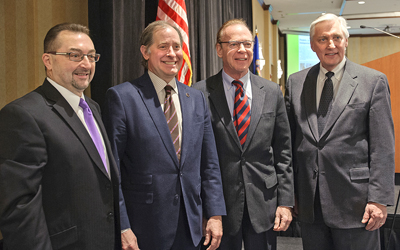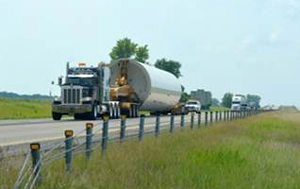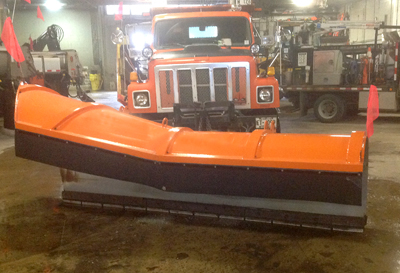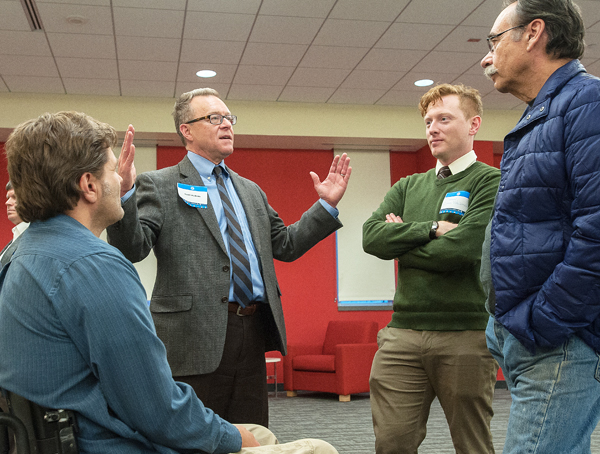 |
|

|
 |
TABLE of CONTENTS
 |
Bridges, buses, bidding and more: 2015 Minnesota Transportation Conference has it all |
By Chris Joyce

Commissioner Charlie Zelle (second from left) joined past commissioners Tom Sorel, Len Levine and Elwyn Tinklenberg March 4 during a panel discussion at the 2015 Minnesota Transportation Conference. Photo by David Gonzalez |
More than 1,500 transportation professionals packed the 2015 Minnesota Transportation Conference in Bloomington March 3-5 to hear about the latest innovations in the field and catch up with colleagues.
The conference opened with an evening reception March 3, followed by two intense days of breakout sessions highlighting the contributions of engineers, planners, researchers and other experts in the multimodal transportation realm.
Commissioner Charlie Zelle introduced Gov. Mark Dayton, who officially kicked off the conference March 4.
“The governor and I just arrived. We experienced the 19th most congested transportation system,” he said to laughter, referencing the Interstate 494/I-35W interchange in Bloomington. The interchange was the subject of a recent news conference on the governor's transportation funding proposal.
“Failure to think ahead (about funding) will strangle the future of transportation,” Dayton told the conference assembly. “Let’s be honest: raising revenue means raising taxes.”
The governor said that those who think the looming transportation funding problem can be solved solely by finding more government efficiencies, “as if there were fountains of government waste,” are wrong.
“If it’s bad now, we know it’s going to get worse,” he said. “We’re responsible to future generations.”
One of the featured general sessions was a panel discussion with past MnDOT commissioners Len Levine (1986-91), Elwyn Tinklenberg (1999-2002) and Tom Sorel (2008-12), and current commissioner, Charlie Zelle (2013 to present). Moderated by former Minnesota Secretary of State Mark Ritchie, the panelists shared signature accomplishments during their terms as well as their vision for Minnesota’s future transportation system.
They even had advice for Zelle.
“Work with both sides (of the political aisle). I personally met every member of the Legislature,” Levine said. “A road doesn’t know whether it’s Democrat or Republican.”
Under Levine, MnDOT worked with legislators and managed to get a three-year, $350 million funding package passed that included a three-cents per gallon gas tax increase.
“It was a team effort,” he said, that involved Deputy Commissioner Doug Differt, district engineers and every employee.
Tinklenberg, whose tenure saw the construction of Minnesota’s first light rail transit system amid opposition, said it’s important to find a common way to move forward, but to “move forward boldly.”
Much of Sorel’s term, which began eight months after the I-35W bridge collapse, focused on rebuilding public trust and confidence in MnDOT.
His advice for keeping transportation and healthy communities in balance?
“Transform our thinking…Five, 10 years in the future, we’ll be judged on how we’ve affected people’s quality of life,” Sorel said.
The conference also included 48 breakout sessions, many of them with MnDOT staff presenting or moderating. These sessions covered a wide range of topics, including:
- ABCs of Accelerated Bridge Construction
- Cutting-Edge Road Safety Technologies
- Drones: The Future is Now
- Taking Public Engagement to the Next Level
- High-Impact Improvements on a Budget: Hwy 10
- Bike and Pedestrian Planning
- Implementing the Strategic Highway Safety Plan
Presentation materials from all sessions will be posted soon at http://mntransportationconference.org.
|
 |
|

|
 |
TABLE of CONTENTS
 |
Senate confirms Commissioner Zelle |
| By Chris Joyce
The Minnesota Senate again confirmed Charlie Zelle March 5 as state transportation commissioner, a formality necessitated by the re-election of Gov. Mark Dayton last fall. Zelle first was confirmed as MnDOT commissioner in February 2013.
A few days before the full Senate vote on his confirmation, Zelle appeared before the Senate Transportation and Public Safety Committee for the first round in his confirmation process. During nearly 50 minutes of testimony and questions, the commissioner recapped his transportation background and highlighted some of the agency’s many accomplishments during the past two years.
Some of the accomplishments he cited include establishing MnDOT’s Enhancing Financial Effectiveness goal, integrating accountability into MnDOT’s organizational structure and processes, launching the Corridors of Commerce program, leading the development of tribes and transportation (government-to-government) training, and elevating diversity and inclusion within MnDOT.
“It’s not just a nice thing, it is essential for our future,” said Zelle, who also sits on the governor’s statewide Diversity and Inclusion Council.
Throughout the hearing, senators of both political parties thanked Zelle for his “open-mindedness” and for “getting out in Greater Minnesota,” where the commissioner has spent much time during the past two years talking transportation needs and funding realities with communities throughout the state. |
 |
|

|
 |
TABLE of CONTENTS
 |
Manufacturing study helps MnDOT understand, take action on transportation needs |
|
By Sue Roe

Manufacturing companies often travel on highways to get their products to market. A study in District 8 led to several changes that will help those companies transport their products to market efficiently and safely. A study is currently under way in District 4. Photo by David Gonzalez |
A project to understand what transportation issues the state’s manufacturers face is already providing solutions in District 8, and is now under way in District 4.
The “Manufacturers’ Perspectives on Minnesota’s Transportation System” effort started as a pilot project in 2013. The intention was that if MnDOT could use what it learned to take meaningful action steps, the study would expand, according to Donna Koren, project manager.
“The goal was to align MnDOT’s transportation program as much as possible with manufacturers’ transportation issues,” said Koren, who works in the Office of Customer Relations. “We gathered actionable information from the District 8 interviews, so we decided to improve and implement the model in District 4 and are now drafting a five-year, statewide plan.”
During the District 8 project, MnDOT and locally based economic development staff conducted one-on-one interviews with 75 manufacturers and carriers at their plants and offices.
Manufacturers voiced concerns about such topics as smooth pavement for shipping fragile products and livestock, bridge clearance and capacity, wide shoulder for safety margins, priority routes for snow and ice operations so shippers and carriers can meet production and delivery schedules, improved signage and signaling to enhance safety and efficiency, and improved communication during construction projects.
MnDOT addressed some issues immediately, such as signing up companies for email construction and road condition information, and helping to facilitate a permit, which led to a $1 million manufacturing expansion and 25 new jobs at one plant.
District 8 also changed its construction detour planning to take place a year ahead of construction, giving MnDOT time to bring shippers’ input into that process, and providing manufacturers longer lead time to plan alternate routes, one of their stated priorities.
During one interview, a dairy operator said his milk products need to be transported around the clock, including during snowstorms and throughout the construction season. The company hauls seven million pounds of milk per day and contributes to a $2.5 billion industry in the state.
“Now the subarea supervisor notifies the dairy when the road will be plowed so the dairy trucks can be sent out behind the plow,” Koren said. “It’s no cost to MnDOT, but helps the producer transport milk more efficiently and safely.”
In other interviews, a farmer explained how rough roads cause pigs to suffer broken limbs while being transported. A manufacturer said rough roads cause damage to approximately 20 percent of products shipped.
“Smoother roads will help the farmers and shippers make those trips without damaging their goods. We wouldn’t have thought of those issues,” Koren said. “It’s good to know the routes that are particularly important to these users with regard to smooth pavement.”
As the project expands to other districts, Koren said the project team anticipates hearing similar experiences. These issues will have statewide implications, such as how MnDOT designs roundabouts and turn lanes, improves signage and expands the functionality of 511.
“Staff realized that hearing these manufacturers’ experiences shows how much our day-to-day work and decisions affect the operations and success of these businesses and sustain the region and the state,” said Koren.
In the District 8 study, a project team of five MnDOT staff conducted the interviews, paired with local economic development professionals. In the District 4 study, about 20 employees were involved, including engineers and planners from District 4 and Freight and Commercial Vehicles staff, and about 15 economic development staff. A total of 103 interviews were conducted in District 4. MnDOT also is partnering with the University of Minnesota’s State and Local Policy Program and the Minnesota Management and Budget’s Management Analysis and Development on both projects.
“We found out there are benefits to having our staff conduct the interviews, so we expanded MnDOT staff participation,” Koren said. “Manufacturers thanked us for coming out and listening. They know we’re reaching out because we want to be responsive. This level of outreach helps builds relationships and helps us do our part to keep the state’s economy vital.”
The District 8 report is online at http://www.dot.state.mn.us/d8/projects/manufacturersperspectives/index.html.
The District 4 report will be available this spring. |
 |
|

|
 |
TABLE of CONTENTS
 |
Snowplow operators invent new, hybrid plow design |
By Shannon Fiecke

Snowplow operators in District 8 worked with Falls Plow in Little Falls to create a plow that uses the wind to cast snow from the road without impeding traffic or the operator’s view. Photo courtesy of District 8 |
MnDOT snowplow operators in southwestern Minnesota have invented an experimental plow that uses the wind to cast snow from the road without impeding traffic or the operator’s view.
Manufactured for MnDOT by Fall Plows in Little Falls, Minn., the plow incorporates half of a traditional bulldozer style plow with half of a batwing-style plow. It eliminates the large “ear” on the driver’s side of a batwing style plow that can stick out into oncoming traffic during centerline snow removal.
“We were looking for a reversible-style plow that could be used in the heavy winds and reduced visibility from blowing snow that are prevalent in western Minnesota,” said Dennis Marty, District 8 maintenance supervisor.
When drivers are plowing against a northwest wind in rural Minnesota, the snow coming out of the chute will sweep across the truck and blind drivers, so operators needed a plow with a reversible system so they could throw the snow with the wind.
While an express plow with chutes on both ends (batwing-style), was great for throwing snow to the right, when snow plow drivers took it down narrow two-lane roads, the plow stuck 2.5 feet into the oncoming lane and its big barrel partially blocked the headlights and the operator’s view.
So operators tried a regular one-way plow, which resembles a funnel laid on its side, and put it on a reversible system that would allow operators to turn the plow both directions, so it could throw snow to the right or the left. However, this plow couldn’t blow snow high enough to the left and so snow piled in the left traffic lane.
Marty said he spent four to five years looking for a plow that combined the batwing and bulldozer designs, but he couldn’t find anything sturdy and maintenance-free enough. Finally, he and Ryan Otte, maintenance research program administrator, sat down with Falls Plows and asked the company to build one.
The plow will be useful on low-volume roads that have little traffic during the middle of the night, which allows plow operators to cast the snow with the wind.
The Willmar office began using the experimental plow last winter and will be replacing all of its fleet with it. Snowplow drivers from other areas of the state have been so impressed that at least two other maintenance districts have also ordered them. |
 |
|

|
 |
TABLE of CONTENTS
 |
Metro District hosts combined projects open houses |

Scott McBride, Metro District engineer, spoke to attendees during a recent project open house. The Metro District held several open houses in the western suburbs to inform attendees about multiple projects taking place this summer. The purpose of the open houses was to present an overview of the eight-mile construction project on Interstate 494 between I-394 in Minnetonka, the I-94/694 Interchange in Plymouth and Maple Grove, constructing an auxiliary lane on Hwy 12, extending Hwy 610 from Hwy 81 to I-94, and resurfacing I-394.
“It’s not uncommon for us to be working on several different construction projects in the same vicinity, at the same time,” said Ron Rauchle, Metro District west area engineer. “Featuring several area projects in a single open house format not only provides a one-stop shop for those seeking information on multiple projects, it also demonstrates that we indeed are coordinating multiple projects in an effort to minimize traffic impacts." Photo by David Gonzalez |
|
 |
|

|
|
| |
|



